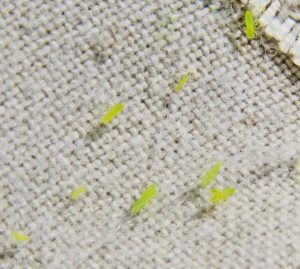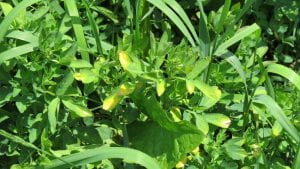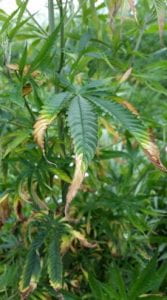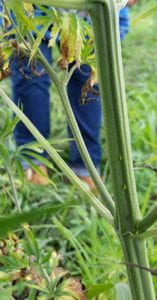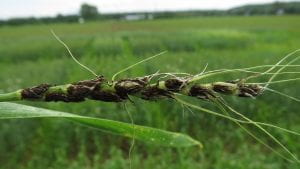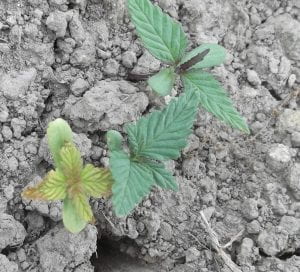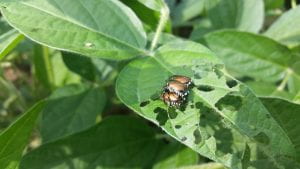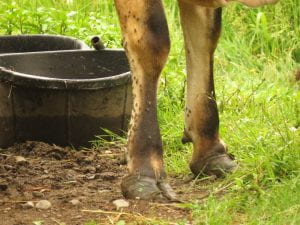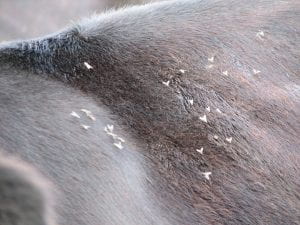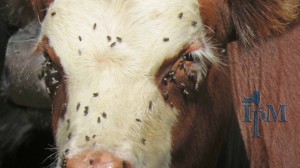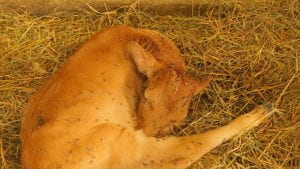Contents
View from the Field
Potato leafhopper
The pest of the week is potato leafhopper (PLH) on alfalfa. There are reports of PLH over threshold in many fields across the state, including in some hemp fields in Tompkins County. The eggs that the adult potato leafhoppers laid have hatched, and nymphs are now in fields. The population will explode in this hot weather. If you are over threshold, you have a few options:
- If the field is within 7-10 days of harvest, and is over threshold for PLH, it is best to harvest the alfalfa now to maintain the quality of the forage.
- If the alfalfa is not within 7-10 days of harvest and is over threshold for PLH, but does not show the v-shaped yellowing, an insecticide should be applied.
- If alfalfa is short and damage (v-shaped yellowing across the field) has occurred, it is best to clip off the alfalfa and monitor the regrowth for PLH.
Potato leafhopper damage on hemp (photos by J. Cummings)
Loose smut on barley
Josh Putman (CCE Southwest Dairy, Field Crops and Livestock Team) reports finding high infestation rates of loose smut on barley.
Damping-off of hemp seedlings
Gary Bergstrom reports issues with damping-off of hemp seedlings in Tompkins and Ontario counties. Damping-off can be caused by a number of fungal pathogens, including Pythium, Fusarium and Rhizoctonia. Fungicidal seed treatments are typically employed in most crops to manage this issue. However, hemp has a very limited number of pesticides registered at this point.
Japanese beetle damage in soybean fields
We are starting to get reports of low levels of Japanese beetle damage in soybean fields. Keep an eye out for these pests while scouting. Not many fields require insecticide applications for Japanese beetle damage in soybean annually in NY. The action threshold for spraying to manage this pest is when you observe 25% defoliation during vegetative growth stages, 15% defoliation from initiation of flowering to pod set, or 25% defoliation after during pod fill to maturity. Keep in mind that damage caused by driving over the crop for pesticide applications may result in higher losses than from insect feeding alone, and that insecticide applications are most cost-effective before the V6 growth stage for defoliating pests, like the Japanese beetle. Below is a list of products labeled for use for managing Japanese beetles in soybeans in NYS. (This list may not be comprehensive and is in no way a promotion of any products listed)
Flies on Cattle 2020
We are getting reports of flies on cattle. We have four species that can cause economic losses with dairy and beef cattle. These are horn flies, face flies, stable flies and houseflies. Horn and stable flies require blood meals to reproduce and have painful bites. Horn flies can take 20 blood meals per day. There can be hundreds of horn flies on one animal. Stable flies take a least 3-blood meals a day. I have seen more than a hundred on the legs of each animal in extreme situations. That is a lot of painful biting.
Face and house flies have spongey mouthparts. Face flies like to feed on fluids that cattle exude around the eyes and nose. Face fly mouthparts are a little like sandpaper and they rasp on a spot to stimulate the eye to release more fluid. They will also feed on cuts and wounds on the animals. Face fly can transmit pinkeye and Thelazia eye worm. Houseflies can occur at very high populations and can annoy animals in barns. Houseflies also can transmit diseases.
The combination of all four can cause a lot of annoyance and stress on the cattle reducing their time feeding thus, reducing milk production and weight gains. For more information on these flies, please refer to the following videos (English & Spanish) and publications:
Short Videos
- House Flies houseflies (Musca domestica) in Dairy Barns
- Moscas domésticas (Musca domestica) en establos lecheros
- Barn Fly Alternative Management Practices: House and Stable Flies
- Alternativas de manejo para el control de Moscas domésticas y de establos
Publications
Elements of IPM for Pastured Beef Cattle in New York State
Elements of IPM for Dairy Cattle in New York State
Pest Flies of Pastured Cattle and Horses
Integrated Pest Management Guide for Organic Dairies
Guía del Manejo Integrado de Plagas (MIP) para los Ranchos Orgánicos
Pest Management Recommendations for Dairy Cattle
Integrated Management of Flies in and around Dairy and Livestock Barns
Degree Days Base 50 F
From March 1, 2020 to July 4, 2020
| Station Location |
(Base 50) March 1 |
| Canton | 826 |
| Ceres | 766 |
| Chazy | 795 |
| Cobleskill | 781 |
| Geneva | 941 |
| Highland | 1043 |
| Ithaca | 879 |
| Kinderhook | 1012 |
| Malone | 760 |
| Massena | 789 |
| Oriskany Falls | 876 |
| Red Hook | 1030 |
| Versailles | 907 |
| Watertown | 812 |
Clipboard Checklist
Keith Waldron, NYS IPM
General
*Walk fields to check general field condition, weed issues
*Watch for crop maturity, stand assessments, weed escapes, nutrient deficiencies, lodging issues
Alfalfa:
*Evaluate established legume stands for approximate days until harvest
*Monitor potato leafhopper, foliar, systemic and crown rot diseases.
*Monitor new seedings for potato leafhopper, pythium blight, phytopthora root rot.
Small Grains:
*Monitor small grains for signs of Fusarium Head Blight, foliar diseases
*Monitor grain fields for growth stage, disease issues, grain maturity, harvest timing
*Record diseases present, location and types of weed escapes
Corn:
*Monitor for mid-season corn pests including European corn borer, corn rootworm, western bean cutworm, slugs, foliar diseases such as northern corn leaf blight and gray leaf spot, weed issues, nutrient deficiencies, vertebrate damage.
Soybeans:
*Monitor for crop growth stage, soybean aphid, defoliators, foliar diseases, white mold, weed issues, vertebrate damage
Pastures:
*Check water sources, mend fences as needed.
*Check crop growth, clip pastures between grazing as needed
*Monitor for invasive species, plants harmful to livestock
*Review/Plan rotations
Equipment:
*Carry appropriate/necessary NYS DEC and EPA documents as needed: (pesticide applicators license, pesticide labels, MSDS sheets, etc.)
Storage:
* Check stored grain bins for temperature, moisture and signs of mold and insects. Aerate, core, transfer grain or treat as necessary
* Clean and disinfect empty storage bins in preparation for grain harvest
*Check forage allocation and anticipate feed program adjustments as forages from previous year are used up
*Mow around storage bins and facility to minimize pest hiding places
Dairy Cattle Barn Fly Management:
*Monitor animals and barn area for house fly, stable fly and other pest management needs including presence of rodents and birds.
*Check facilities for favorable fly breeding conditions: (organic matter + moisture): leaks in watering systems, roof gutters for leaks and potential overspill, drainage,
*Sanitation, sanitation, sanitation – clean animal resting areas, feed troughs, minimize source of moist organic matter i.e. fly breeding areas in barn and in adjacent animal loafing yard
* Continue fly monitoring: install “3X5″ index card fly speck monitoring cards throughout barn
*Use, replenish, replace fly management materials: sticky fly tapes/ribbons, insecticide baits, natural enemies (parasitoids), fly population monitoring (3 x 5) spot cards
*Consider purchase and release of Muscidifurax raptor and/or M. raptorellus natural enemies of house and stable fly pupae.
Dairy Cattle on Pasture:
*Monitor animals for presence of face flies, horn flies and stable flies. Action guidelines: face flies (average 10 per animal face), horn flies (average 50 / dairy per animal side, 200 / beef cattle per animal side), stable flies average 10 per animal (all four legs)
*Check feed bunk / water source locations for signs of stable fly breeding (moist undisturbed organic matter – spilled feed, round bales, etc.), minimize source of moist organic matter i.e. fly breeding areas in barn and in adjacent animal exercise yard.
*Check pasture for forage quality / quantity, rotate as appropriate
*Check pasture for vegetation poisonous to livestock
*Consider use of pasture fly traps to help reduce deer, horse and stable fly populations


